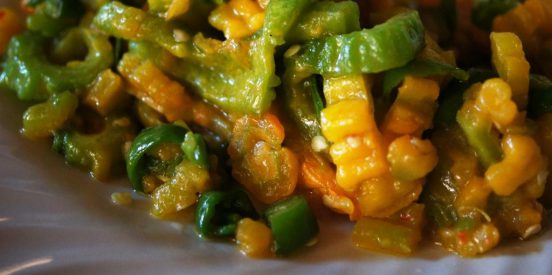We just experienced a taste that transported us right back to China, and from ingredients that were mainly home-grown: two meals, two dishes of bitter melon.

Like the chile pepper, bitter melon is an acquired taste. This gourd/cucumber/melon, also called balsam pear (a euphemism if ever there was one – in Chinese it is 苦瓜, KuGua, which can be translated directly as bitter melon, in Japanese it is/seems to be goya)) may even be more so than peppers: it’s supposed to be very healthy, and it definitely is bitter like a medicine, without even just offering any of the fun burn that peppers give. On the first eating, in particular, one wonders whether it should even be eaten at all.
Then again, it is a vegetable that gets eaten from Japan via China through Southeast Asia and India. And let’s not forget that there are quite a few such things, and they all have peculiar properties which make them popular – once the first resistance is overcome: beer, coffee – and quite a few kinds of bitter greens. Like with coffee, which is made more palatable by combining it with milk and sugar (or cinnamon), there are ways of making KuGua nicer, if not outright tasty.
First of all, it needs to be cut open and the seeds – which are (said to be) poisonous – removed. Then, the fruit gets cut into slices – preferably, very thin ones.
Restaurants, it seems, even blanch it in hot water to remove some of the bitterness; one gets used to it quickly enough (if not a “supertaster” who is particularly sensitive to taste) though, anyways.
The best beginner’s KuGua dish, in my opinion, is KuGuaChaoDan (苦瓜炒蛋), Fried Egg Bitter Melon:

Take the bitter melon slices and fry them for some five minutes in hot oil (they should get a bit softer, maybe start to turn very, very slightly brownish, but not more), then add 1-2 eggs and fry it all. (Restaurants have some trick to get the egg to stick to the KuGua, but I frankly don’t know how they do it.) Salt to taste.
The combination of egg and salt makes the bitter melon much less bitter, and the whole mixture is very flavorful.

Less for the beginner is KuGuaQingJiao (苦瓜青椒), Bitter Melon with Green Peppers. Again, the KuGua is de-seeded, cut into slices. Green chile pepper is also cut into slices. Both are fried for a few minutes, salted – and served. Somewhat hot , depending on the chilli, and definitely bitter, this dish brings out more of the original flavor and is thus about as tasty as tonic water: Once you get used to it, there’s just something about it that makes it enjoyable. Before then, however, it’s just good for never again thinking that broccoli or Brussels sprouts are bitter.
It’s interesting to note the development of taste impressions, anyways.
At first, KuGua is hard to bear, if not something for which human inborn warning systems just scream bloody murder. Too bitter, beh!
Then, however, you get used to it, and start to like it. It’s refreshing, it’s something different, and hey, it’s healthy for you , too. Especially in this day and age of ubiquitous junk food appealing to the most basic and worst of instincts regarding eating, the lessons of such resisted flavors are very much needed: You have to learn to like what real, and really good, food is like, not just look for what’s immediately appealing. And besides: if you have the slightest decent foundation of taste and appetite education, junk food will not appeal quite as much.

Leave a Reply
You must be logged in to post a comment.